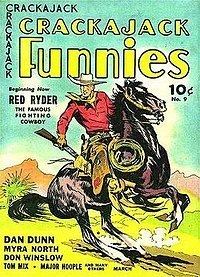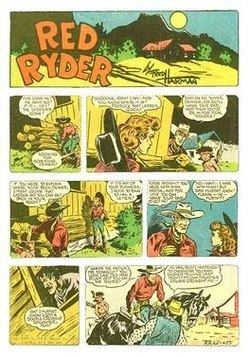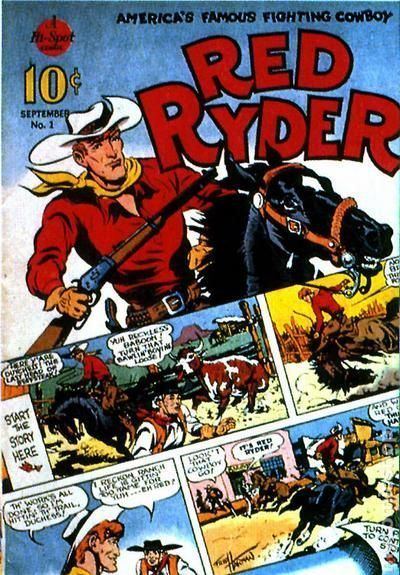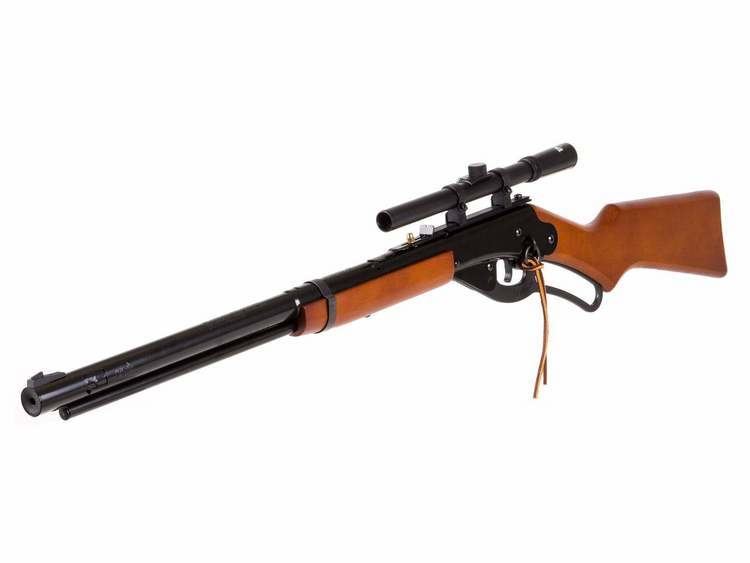Current status / schedule Ended Genre(s) Western Syndicate United Media | Launch date November 6, 1938 End date 1964 | |
 | ||
Similar King of the Royal Mounted, Bronc Peeler, Dick Tracy, Little Orphan Annie, Alley Oop | ||
Red ryder comics 72
Red Ryder was a Western comic strip created by Stephen Slesinger and artist Fred Harman, which served as the basis for a wide array of character merchandising. syndicated by Newspaper Enterprise Association, the strip ran from Sunday, November 6, 1938, through 1964.
Contents
- Red ryder comics 72
- Bronc Peeler
- Red Ryder
- Characters and story
- Comic books
- Radio
- Films and television
- Republic Pictures
- Eagle Lion Films
- Products
- Parody
- References

Bronc Peeler
Harman was on a Colorado ranch when he decided to draw a comic strip. He headed for Hollywood in the early 1930s, borrowed some money and began Bronc Peeler, which he syndicated himself. Bronc Peeler was a rough cowboy who fought bandits and rustlers with the help of his pal, Coyote Pete. Harman's rough-hewn art style had a dramatic appeal, but his characters, who killed animals and people, coupled with the affected use of slang and thin storylines, were not in keeping with the content standards needed for wide syndication.
Red Ryder

In 1938, when Harman met publisher/comic syndicator Slesinger, who brought Harman to New York and worked with him for a year before Red Ryder was ready to be syndicated. Slesinger then embarked on a successful campaign of merchandising and licensing, with comic books, Big Little Books, novels, serial chapters, radio programs, events, rodeos, powwows, commercial tie-ins, and licensed products such as the Daisy Red Ryder BB Gun. The appeal of the Daisy Red Ryder BB Gun to youngsters was depicted in the Christmas film A Christmas Story, adapted from the autobiographical fiction of Jean Shepherd, by permission of Red Ryder Enterprises, Inc., which owns the Red Ryder trademarks and copyrights.
Characters and story

Astride his mighty steed Thunder, Red was a tough cowpoke who lived on Painted Valley Ranch in the Blanco Basin of the San Juan Mountain Range with his aunt, the Duchess, and his juvenile Native-American sidekick, Little Beaver, who rode his horse, Papoose, when they took off to deal with the bad guys. Little Beaver spoke in the pidgin English now considered an offensive caricature. (Example: "Spinach heap good. Me like'm!") Other notable characters were ranch hand Buckskin Blodgett, Red's gal pal Beth, and bad guy Ace Hanlon.

Harman was eventually acclaimed as one of the finest Western pen-and-ink artists, known for his dramatic sense of perspective and authentic action. Contributing artists and writers worked on the strip over the years, including Stephen Slesinger who scripted and approved all of the stories until his death in 1953; Jim Gary, Edmund Good, John Wade ("Johnnie") Hampton, Robert MacLeod, and Bill Lignanti (of The Palm Restaurant fame). Charlie Dye, Johnnie Hampton, Joe Beeler, and George Phippen were co-founders of the Cowboy Artists of America of which Harman was also a charter member. When Harman left Red Ryder in 1963 to concentrate on his paintings, MacLeod continued writing the story continuity for the strip, with staff artists of Red Ryder Entp., Inc.

Gaylord DuBois, a prolific comic book writer associated with Slesinger, scripted Red Ryder and Little Beaver for a short period in 1938 and again in the early 1940s.
Comic books

The first Red Ryder comic book was published by Slesinger's Hawley Publications, Inc. in September 1940, followed by Hi-Spot comics for one issue. Dell Comics launched its Red Ryder in August 1941, changing its title to Red Ryder Ranch Magazine with #145, and then to Red Ryder Ranch Comics with #149. Red Ryder Comics consisted of reprints of the newspaper strip until issue #47 (June 1947), when it began producing original material. Altogether, the title ran for a total of 151 issues, ending in 1957, one of the longest continuous newsstand runs of any Western comic.
Radio
The Red Ryder radio series began February 3, 1942, on the Blue Network. broadcast three times a week at 7:30pm Pacific time. When the Blue also acquired The Lone Ranger from the Mutual Broadcasting System, Mutual decided to compete by airing Red Ryder in the same time period. Thus, Red Ryder aired on the East Coast that year from May 20 to September 9 on Mutual. The series beat The Lone Ranger in the Hooper ratings, but the success was short-lived. Red Ryder was sold to a regional sponsor, Langendorf Bread, and after four months was no longer heard in the East.
Mutual and Langendorf continued the series on the West Coast Don Lee Network through the 1940s at 7:30pm on Tuesdays, Thursdays, and Saturdays, always with the familiar organ theme, "The Dying Cowboy" ("Bury Me Not on the Lone Prairie"). Announcers on the show included Ben Alexander and Art Gilmore.
The continuing characters of the comic strip were also found in the radio series, produced by Brad Brown with writer-director Paul Franklin and writer Albert Van Antwerp. Reed Hadley portrayed Red Ryder on radio from 1942 to 1944, followed by Carlton KaDell (1945), and Brooke Temple (1946–51). Arthur Q. Bryan had the role of Roland "Rawhide" Rolinson, and Red's sidekick Buckskin was played by Horace Murphy. Jim Mather provided Indian voices.
Numerous actors played Little Beaver: One of the most notable was Robert Blake (on credits as Bobby Blake), Tommy Cook (1942 on), Frank Bresee (1942–46, alternating with Cook), Henry Blair (1944–47), Johnny McGovern (1947–50), and Sammy Ogg (1950–51). During the same mid-1940s time frame, Henry Blair also portrayed Ricky Nelson on The Adventures of Ozzie and Harriet.
Billed as "America's famous fighting cowboy," Red Ryder was notable because he usually did not kill his enemies but instead aimed for the hand to disarm them. Such sound effects were handled by James Dick, Monty Fraser, and Bob Turnbull.
Films and television
Red Ryder appeared in more than 35 movies and serials. They began in 1940 with the 12-chapter Republic movie serial The Adventures of Red Ryder, played by Don "Red" Barry, who got his nickname "Red" from the role and Tommy Cook as Red Ryder's young Indian sidekick Little Beaver. Subsequently Wild Bill Elliott and Allan "Rocky" Lane portrayed Red Ryder in a number of films, both working with Robert Blake as Little Beaver. The last four Red Ryder movies starred Jim Bannon as Red Ryder and Don Kay ("Little Brown Jug") Reynolds as Little Beaver. All four of these movies were done in color. Both Bannon and Lane filmed pilots for a Red Ryder television series, but neither version sold. Both pilots survive and appear on various western DVD collections.
Republic Pictures
Eagle-Lion Films
Products
Slesinger's marketing synergy for Red Ryder and Little Beaver products was equally trail-blazing. Red Ryder toys, novelties, gifts, accessories, sporting goods, and rugged outdoor, work and play clothing were sold nationwide and were exported by leading North American manufacturers to Europe, Latin America, and as far as Egypt, India, and Japan.
At JC Penney stores across the country, Slesinger created Red Ryder "outposts for dependable American quality and value." These stores within the store were called "Red Ryder Corrals." In addition to educational and sportsmanship contests, special events and personal appearances, they supplied Red Ryder Brand rugged clothing for men and boys. In addition to Red Ryder and Little Beaver outdoor products, licensing included school supplies, lunch kits, and other Red Ryder character hardware and sporting goods.
The outposts also included the legendary Daisy Red Ryder Carbine, which became a father-to-son Christmas gift tradition as memorialized in the 1983 Jean Shepherd film A Christmas Story. The story revolves around the author's childhood memories and a boy trying to get a "Red Ryder Carbine-Action Two-Hundred-Shot Range Model Air Rifle BB gun with a compass in the stock and a thing which tells time" for Christmas.
Parody
Buckaroo Bugs (1944) features Bugs Bunny in the Wild West with "Red Hot Ryder" as his nemesis.
